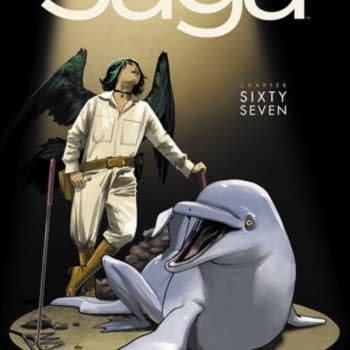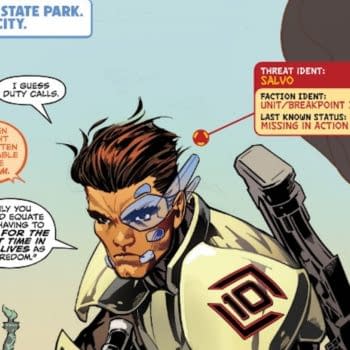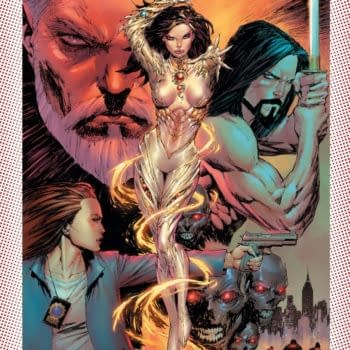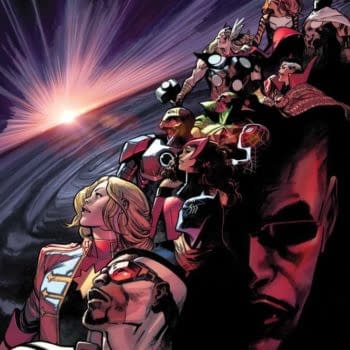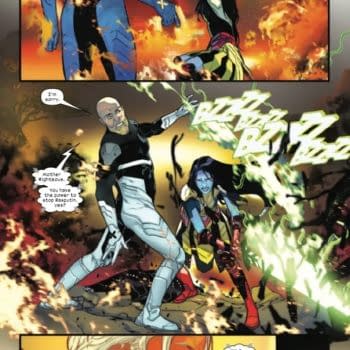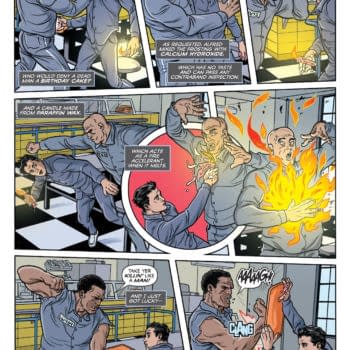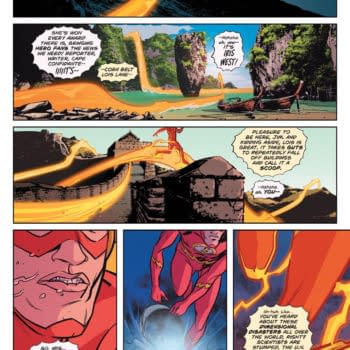Posted in: Comics | Tagged: Comics, dexter, marvel
The Virtues And Vices Of A Dexter Comic
[*mild spoilers for Dexter #1 from Marvel Comics below]
Promo leading up to Marvel's Dexter comic has been careful to distance it a little from the cult-following Showtime television series, but it's impossible to completely distance it when the title and the character appeal draws so heavily on a vast fan-base for the show. The differences are specific: the comic is slated to follow the ideas of the novel series by Jeff Lindsay more closely, and not to intersect directly with the plotlines of the show, which only followed Lindsay's books closely during its first season anyway. The fact that Lindsay himself is scripting the comic is in many ways a coup that separates the comic from many movie and film tie-in comics out there in increasing numbers. But for fans who have read Lindsay's books (soon to be 7 in number) or who have only been following the TV series, is Dexter: the comic going to appeal? What can the medium bring to the material to make it a worthwhile project?
Artist Dalibor Talajic is known for his work on several Marvel series from Deadpool to X-Men, Deadworld, and Hit-Monkey, and isn't so immediately recognizable in his style that it might throw readers into a state of distraction. There's something to be said for that. When the story and characters are so well known, it might not make sense to bring a storm-and-thunder art influence to bear. However, the TV series is known for its visual style, which might have been what led Marvel to take the idea of a comic book Dexter seriously. There's the overpowering white heat of middays in Miami, the terra cotta colors of stucco neighborhoods, the ever-swaying palm trees, all poised to contrast with the sticky red of inevitable blood-spatter. Even at night, the show drips locale with its multi-colored neon lights in seedy clubs and its rusty waterfront warehouses. Showtime's Dexter is as visual an experience as you could hope to encounter outside of HBO or the movies, and certainly something that other channels like AMC are emulating in Madmen. Intense design seems like the rule of the day for the TV renaissance underway right now. Does the comic give Talajic adequate room to rev his engines and show what he's capable of to set the aesthetics of the comic? Colorist Ive Svorcina is going to have some heavy-lifting in that department, too.

Characterizing Dexter's visual appearance has got to be tough since he contains so much of the narrative within his own psychological world. Talajic has chosen to pick a certain ordinariness for Dexter's face and facial expressions, neither particularly strong nor weak, and exceptionally devoid of interest or reaction. At first, that can be a little disturbing in a comic book, a medium that has always depending heavily on facial character and extremes of emotion and reaction to help tell the story. Talajic is veritably breaking with the traditions of the medium here in favor of serving the unusual story material. There's no question that Lindsay's Dexter, whether of the books or the show, has built his life upon blending in to normalcy, chameleon-like, but that one of his most telling features is his lack of empathy and reaction to others around him. Those basic aspects of the character make Dexter one hell of a challenge to translate into comics.
But the general blandness of Dexter's facial expressions, ranging from boredom to discomfort, does contrast well with the chaotic social situations he faces when his wife Rita drags him along to his high school reunion. And his discomfort, consequently, reaches the reader as a point of identification. Portraying young Dexter in flashbacks with a slight, but understated sepia tone is a worthy choice from Svorcina, and the flashbacks gives Talajic a little more room to portray an active, angry Dexter rather than a person on blending-in lockdown. One thing to notice, though, is that Rita and Dexter's old/new nemesis Steve Gonzales are also depicted in a slightly meditative, still way that's similar, but not as generic, as the way that Dexter is portrayed.
That gives the comic an atmosphere that's a little dream-like but also enigmatic, and maybe even a little slow-moving, no matter how well the page layouts may convey action and liveliness. It could be a move to create an iconic sense of atmosphere appropriate to the books and this new comic venture, but it's also a danger in creating lag. Talajic's most interesting visual development in this issue #1 (and presumably throughout the series) is the presentation of Dexter's "Dark Passenger" killer self as an inky, flowing vertiginous wraith that spreads around him and around those he wishes to kill. That's something the show couldn't really do without breaking with visual realism, but the comic can certainly get away with it as the lines between perception and state of mind blur. If we see more of that risky concern for the psychological truths of the books in the comic, it could really make a mark on the Dexter phenomenon in pop culture.
The artwork is a mixture of virtues and potential vices, but the writing, predictably, is incredibly solid. Lindsay brings readers all new vignettes from Dexter's personal life and takes us back inside his marriage to Rita, when the show has moved on and rendered Dexter a single Dad. This is what happens when you manage to bring the creator of a character on board with a comic adaptation: the have the opportunity to go through their tool box and produce bits and pieces suited to fannish curiosity and pull back the curtains on the inner workings of our serial killer. But what may be surprising is how confidently Lindsay handles the demands of telling a story in the comics medium. He constructs a fairly quickly-moving story jumping between Dexter's nightly duties, his domestic life, and his work life without excessive detail or overly prosy exposition. He hits all the major beats necessary with unhurried but uncluttered pace and delivers a fair amount of backstory in the process. His dialogue rings true, also, but of course, Lindsay would know exactly how to render it authentic, and that's just what the comic needs to render it appealing.
Dexter's narrative, as in the show, is much of what binds the story together, giving an inner and an outer view of how he interprets life and how others interact with his idiosyncrasies. He remains the still point around which disconnected elements of Miami's criminal element come to rotate, and that's a winning formula in the books, the show, and now the comics. The only way Lindsay could have really gone wrong here would have been to attempt to slavishy or self-consciously to make Dexter "comicsy" as a character (by, for instance, rendering him too boldly as an anti-hero), and thankfully, he's managed to strike a balance between the medium and the demands of an established character. Lindsay also makes full use of varied settings to influence mood in his writing, something of a trademark in his work, and that works to keep the story both grounded and moving. Virtues abound in Lindsay's writing on the comic.
One thing readers might notice is that the comic is not as gory as it could be, though it involves the same types of plot elements that produce plenty of spatter in the show, and though the comic sports a "parental advisory" on the cover, we are reminded that this is a Marvel comic. Speaking of which, it's a little strange that this is a Marvel comic. Were they the most willing to take a risk on the property? Dexter might have been a more natural fit at Dark Horse or Vertigo according to superficial assumptions. There you might have seen more of a Showtimey verve for dismemberment and more shocking contrast between Dexter's home life and Dark Passenger. But working as a Marvel series might provide one element as a result that fans might not expect: a kind of droll realism that does set Dexter apart in the everyday world he inhabits. Under these circumstances the comic might not be as shocking as it could have been, but it might still be unsettling in the right ways.
It's hard to tell with a first issue how the visual language of a new series will evolve. The colors by Svorcina are strong enough that let's hope they won't be tweaked too much. Talajic may show more fully how the strange "stillness" of Dexter's appearance can become part of the nature of his storytelling, provided he gives adequate space to the action that fans are no doubt going to expect, even from a man as methodical as Dexter. Lindsay is likely to continue to set the pace and the tone of a series that promises to reveal more about the formative years of an already compelling character, and if he draws out the tensions in Dexter's domestic life too, all the better. The show produces plenty of reaction from fans each episode, things they liked and things that piqued their annoyance, but the overriding drive to watch the show is something that the comic could tap into with a little more confidence in its own virtues and maybe a little more energy behind its own vices.
Hannah Means-Shannon writes and blogs about comics for TRIP CITY and Sequart.org and is currently working on books about Neil Gaiman and Alan Moore for Sequart. She is @hannahmenzies on Twitter and hannahmenziesblog on WordPress. Find her bio here.











